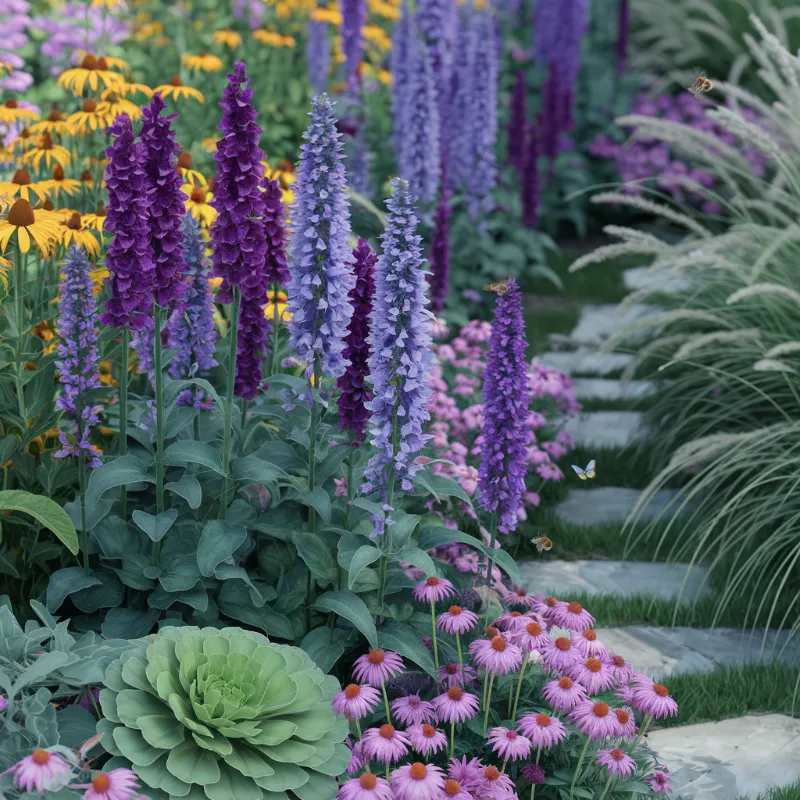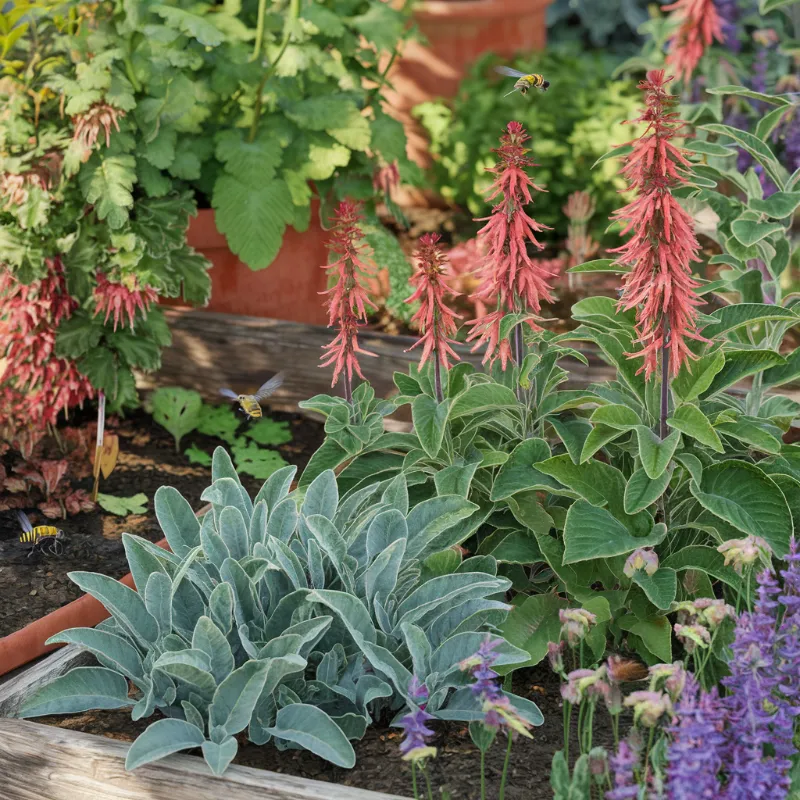Summer afternoons in my grandmother’s garden were always full of color. But nothing caught my eye like the stunning salvia plants. They made her garden a living work of art, turning simple spaces into breathtaking sights. So it’s key to understand landscape uses of salvia.
Salvia is incredibly versatile, with almost 1,000 species worldwide. About 50 of these are native to North America. This makes them perfect for creative landscaping, adding beauty and function to any garden.
These plants grow well in USDA hardiness zones 5 through 9. They can reach heights of 2 to 5 feet, creating stunning visual effects. Plus, they’re great for gardens that need little care, thanks to their heat and drought tolerance.
Salvia attracts hummingbirds with its bright red flowers and blooms all season. They’re easy to care for and adapt to different environments. This makes them a top pick for gardeners wanting vibrant, low-maintenance spaces.
Table of Contents
Overview of Salvia Varieties in Landscaping
Salvia is a vast world of plants, with over 900 species. They offer gardeners a wide range of choices for landscaping. These plants can be small ground covers or tall architectural pieces, perfect for vibrant and water-saving gardens.
Salvia gardening tips highlight their ability to thrive in various conditions. Drought-tolerant salvias are now popular for their beauty and resilience in gardens.
Common Types of Salvia for Gardens
- Blue Salvia (Salvia farinacea): Grows up to 3 feet tall, perfect for USDA Zones 5-9
- Culinary Sage (Salvia officinalis): Reaches 2 feet tall, ideal for Zones 5-8
- Mexican Bush Sage (Salvia leucantha): Dramatic plant growing up to 3 feet tall in Zones 8-10
- Scarlet Sage (Salvia coccinea): Vibrant red flowers, thriving in Zones 8-11
Characteristics That Make Salvia Ideal for Landscaping
| Characteristic | Benefit |
|---|---|
| Drought Tolerance | Requires minimal water once established |
| Pollinator Attraction | Draws hummingbirds and butterflies |
| Color Variety | Available in blues, reds, purples, and whites |
| Growth Adaptability | Ranges from 12 to 48 inches tall |
Landscapers love salvias for their ability to grow well in tough conditions. They add beauty to any garden. Whether you’re creating a xeriscape or need easy-to-care-for plants, salvias are a great choice.
Nature’s palette is never more beautifully expressed than through the diverse world of salvias.
Benefits of Using Salvia in Your Landscape Design
Gardeners looking for vibrant and eco-friendly landscapes will love ornamental salvia species. These plants do more than just look good. They turn gardens into lively, green spaces.
Attracting Pollinators and Beneficial Insects
Salvia is key for attracting pollinators, making gardens flourish. Studies show these plants can draw about 50% more pollinators than non-flowering plants. The benefits are clear:
- Hummingbirds love the nectar-rich flowers.
- Butterflies and bees find them too.
- They help local wildlife by creating safe spaces.
“Salvias transform gardens from mere landscapes into living, breathing ecosystems.” – Ecological Gardening Institute
Drought Resistance and Low Maintenance
Ornamental salvia species are perfect for saving water in gardens. They need up to 60% less water than other flowers. Plus, they’re easy to care for, making them great for eco-friendly gardens.
- They use less water.
- Need little pruning.
- Grow well in many conditions.
Gardeners can make beautiful, eco-friendly gardens by using these plants. With their long blooming season and ability to boost biodiversity, salvias are smart choices for today’s gardens.
Designing with Salvia: Color and Texture

Salvia landscaping designs let gardeners create stunning outdoor spaces. These plants add color and interest to gardens. They are a favorite among landscape lovers.
Exploring salvia companion planting opens up design possibilities. Salvia’s vertical spikes add height, making other plants look even better.
Plant Companions That Enhance Salvia’s Beauty
Pairing plants with salvia can change your garden’s look. Here are some great plants to pair with salvia:
- Lantana – offers complementary color bursts
- Coneflowers – provide structural diversity
- Ornamental grasses – create textural depth
- Sedum – adds ground-level visual interest
Creating a Vibrant Seasonal Color Palette
To make a lively garden, know what salvia can do. The May Night Salvia is a great example:
- Height range: 18-24 inches
- Bloom period: Late spring to early summer
- Potential second bloom: Late summer with proper deadheading
Group 3-5 salvia plants together for a calming effect. This makes your garden look amazing.
“Salvia transforms gardens from ordinary to extraordinary with its architectural elegance and vibrant colors.”
Landscapers suggest planting salvia 12-18 inches apart for a full look. By choosing the right plants and knowing salvia’s growth, you can create beautiful gardens that change with the seasons.
Salvia as Focal Points in Garden Design
Garden designers see salvia as key for adding drama and structure. With over 900 types, salvia is very versatile in garden design.
Placing salvia wisely turns them into eye-catching highlights. The right spot can boost your garden’s look and guide the viewer’s gaze.
Strategic Placement in Flower Beds
Here are tips for using salvia in flower beds:
- Pick salvia that goes well with other plants
- Use different heights to add depth
- Group 3-5 salvia for a strong effect
- Space plants 18-24 inches apart for growth
Highlighting Architectural Features
Salvia can really make architectural parts stand out. Their unique look and color are great for:
- Setting off pathways
- Highlighting garden edges
- Linking different areas
| Salvia Type | Height | Best Placement |
|---|---|---|
| Small Salvia | 4-6 inches | Front of borders |
| Medium Salvia | 16-24 inches | Mid-garden sections |
| Large Bush Salvia | 5-6 feet | Background or standalone feature |
“In garden design, salvia is not just a plant—it’s a living sculpture that transforms landscapes.” – Professional Landscape Designer
Knowing how salvia grows and looks can make your garden stunning. It can grab attention and inspire wonder.
Incorporating Salvia in Xeriscaping
Drought-tolerant salvias are a great choice for water-saving gardens. Xeriscape gardens are gaining popularity. They help save water while keeping gardens looking good.
Salvias are perfect for those who care about the environment. They do well in tough conditions. This makes them great for gardens that use less water.
Best Practices for Drought-Sensitive Landscaping
- Select native drought-tolerant salvias appropriate to your region
- Group plants with similar water requirements
- Implement efficient irrigation systems
- Use mulch to retain soil moisture
- Choose well-draining soil compositions
Combining Salvia with Other Xeriscape Plants
For a successful xeriscape garden, pick plants wisely. Drought-tolerant salvias look great with other water-saving plants.
| Plant Type | Water Needs | Complementary Characteristics |
|---|---|---|
| Lavender | Low | Similar color palette, aromatic foliage |
| Yarrow | Low | Diverse flower colors, similar growth habits |
| Agave | Minimal | Structural contrast, succulent texture |
By using these tips, gardeners can make beautiful, water-saving gardens. These gardens help local ecosystems and use less water.
“In xeriscaping, every drop counts. Salvia transforms water conservation into a beautiful garden art form.” – Landscape Design Expert
Salvia for Edible Landscapes

Gardeners looking to mix tasty plants with beautiful landscapes will find salvia fascinating. It offers a wide range of flavors and looks great in gardens. This makes it perfect for creating spaces that are both useful and lovely.
Culinary salvias add beauty and function to gardens. With over 200 types, they offer many options for making outdoor spaces edible. These plants are great for turning gardens into places where you can grow your own food.
Edible Salvia Varieties and Culinary Applications
- Salvia officinalis (Common Sage): A classic culinary herb used in many dishes
- Pineapple Sage (S. elegans): Reaches about four feet, offers sweet fruity flavor
- S. microphylla varieties: Tolerant of Zone 7 climates, suitable for seasoning
Enhancing Flavor in Culinary Gardens
To add edible salvias to your garden, you need a plan. Here are some tips for growing culinary herbs:
- Select varieties that match your climate zone
- Plant in well-draining soil
- Ensure adequate sunlight exposure
- Harvest leaves before flowering for optimal flavor
“Culinary salvias transform gardens from purely decorative spaces to productive, flavorful environments.”
Salvia varieties have unique tastes, from peppery to sweet. They are great for cooking and adding beauty to your garden.
Creating Wildlife Habitats with Salvia
Gardens are key ecosystems for local wildlife. Salvia landscaping designs are great for supporting biodiversity. These plants turn outdoor spaces into lively habitats that draw and care for different species.
Native Plant Gardens with Salvia
Creating native plant gardens with salvia for pollinators makes sustainable spaces for wildlife. Choosing native salvia species boosts ecosystem health:
- Attract beneficial insects
- Provide nectar sources
- Support local butterfly populations
- Create shelter for small wildlife
Supporting Wildlife Conservation
Salvia is vital for local wildlife conservation. Different salvia species help in unique ways:
| Salvia Species | Wildlife Attraction | Ecosystem Benefit |
|---|---|---|
| Salvia misella | Butterflies, Bees | Erosion Control |
| Salvia nemorosa | Hummingbirds | Biodiversity Support |
*”Every plant in your garden can be a sanctuary for wildlife.”*
Gardeners can make their landscapes into mini-ecosystems. Understanding the bond between salvia and wildlife is key. Careful selection and placement of salvia species help create caring environments for conservation.
Frequently Asked Questions
What are the benefits of salvia in the garden?
What are the benefits of salvia in the garden?
Salvia is a powerhouse plant in any garden! It attracts pollinators like bees, butterflies, and hummingbirds while repelling pests like deer and rabbits. It’s drought-tolerant, low-maintenance, and comes in a variety of colors, making it perfect for adding long-lasting blooms to flower beds and borders.
What can you use salvia plant for?
Salvia is used for both ornamental and practical purposes. In gardens, it adds height and color, while some varieties, like culinary sage (Salvia officinalis), are used in cooking for flavoring meats, soups, and teas. Certain species, like Salvia divinorum, have been used in traditional medicine and spiritual rituals.
What are the disadvantages of salvia?
While salvia has many benefits, some downsides include its tendency to spread aggressively, especially in ideal growing conditions. Some species are short-lived perennials and may need replanting after a few years. Additionally, certain salvias can be toxic if ingested in large quantities, so keep them away from pets and small children.
What is the native use of salvia?
Salvia has been used by various cultures for medicinal and ceremonial purposes. Native Americans and indigenous groups in Mexico used different salvia species for healing, purification, and spiritual visions. Some varieties were brewed into teas to aid digestion, relieve sore throats, or reduce inflammation.
What is Salvia used for in the landscape?
Salvia is a fantastic addition to landscapes because of its versatility. It works well in borders, cottage gardens, and drought-tolerant xeriscapes. Many gardeners use it for its ability to attract pollinators and as a striking contrast to other plants due to its bold colors and tall, spiky blooms.
What is the original use of Salvia?
Historically, salvia was used for medicinal, culinary, and spiritual purposes. Ancient cultures valued it for its healing properties, using it to treat infections, digestive issues, and wounds. Culinary sage (Salvia officinalis) was especially prized in Europe for cooking and preserving food. Some species were also used in religious rituals for their aromatic and psychoactive properties.

